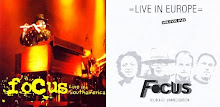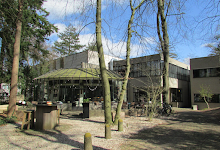Archive number: 61
Title: Blues in D (Live)
Main Album: Live at the BBC
Track number: 2
Genre: Live Jazz Rock Instrumental
Venue: New Victoria Theatre, 17 Wilton Road, London SW1V 1LL (now Apollo Victoria)
Length: 3' 46”
Composer: Bert Ruiter
Musicians: Philip Catherine - Electric guitar; Thijs van Leer – Mellotron, Electric Piano; Bert Ruiter – Bass; David Kemper - Drums
Producer: BBC
Engineer: BBC
Label: Hux Records
Date of recording/release: Recorded March 21 1976 but only released (on CD) June 1 2004
Notes: We begin with the drums and straight away the band is into a keyboard led (electric piano over mellotron) groove as strummed guitar, bass and drums accompany (00:00-00:51). A guitar chord then breaks in and proceedings hang a little as the riff is repeated until the original groove is re-established (00:52-01:30). A crisp guitar next takes up the lead role in a similar jazzy exploratory style (01:31-03:00) the rhythm never failing all the while. At the three minute mark the electric piano briefly comes back in (03:01-03:11) but the guitar is soon back and leads the descent into the close of the piece (03:12-03:35). Applause follows and van Leer can be heard saying 'thank you' (00:36-03:46).
A note on the Blues (from Wikipedia)
Blues is a vocal and instrumental music form based on the use of the blue notes. It emerged in African-American communities of the USA from spirituals, work songs, field hollers, shouts and chants and rhymed simple narrative ballads. The use of blue notes and the prominence of call and response patterns in the music and lyrics are indicative of African influence. The blues influenced later American and Western popular music, as it became the roots of jazz, R& B, rock, etc, etc.
The phrase "the blues" is a reference to the blue devils, meaning 'down' spirits, depression and sadness. An early reference to "the blues" can be found in George Colman's farce Blue devils, a farce in one act (1798). Later during the 19th Century, the phrase was used as a euphemism for delirium tremens and the police and was not uncommon in letters from homesick Civil War soldiers.
Though the use of the phrase in African-American music may be older, it has been attested to since 1912, when Hart Wand's Dallas Blues became the first copyrighted Blues composition. In lyrics the phrase is often used to describe a depressed mood.
There are few characteristics common to all blues, because the genre takes its shape from the idiosyncrasies of individual performances. However, there are some characteristics that were present long before the creation of the modern blues.
An early form of blues-like music were call-and-response shouts, which were a "functional expression ... style without accompaniment or harmony and unbounded by the formality of any particular musical structure." A form of this pre-blues was heard in slave field shouts and hollers, expanded into "simple solo songs laden with emotional content". The blues, as now known, can be seen as a musical style based on both European harmonic structure and the African call-and-response tradition, transformed into an interplay of voice and guitar.
Many blues elements, such as the call-and-response format and the use of blue notes, can be traced back to the music of Africa. The Diddley bow, a homemade one-stringed instrument found in parts of the American South in the early 20th Century and the banjo are African-derived instruments that may have helped in the transfer of African performance techniques into the early blues instrumental vocabulary.
During the first decades of the 20th Century blues music was not clearly defined in terms of a chord progression. There were many blues in 8-bar form, such as "How Long Blues", "Trouble in Mind" and Big Bill Broonzy's "Key to the Highway." Idiosyncratic numbers of bars are also encountered occasionally, as with the 9 bar progression in Howlin Wolf's's "Sitting on top of the world". The basic 12-bar lyric framework of a blues composition is reflected by a standard harmonic progression of 12 bars, in 4/4 or (rarely) 2/4 time. Slow blues are often played in 12/8 (4 beats per measure with 3 subdivisions per beat). By the 1930s, 12-bar blues became the standard. There would also be 16 bar blues, as in Ray Charles's instrumental "Sweet 16 Bars", and in Herbie Hancock's "Watermelon Man".





















No comments:
Post a Comment